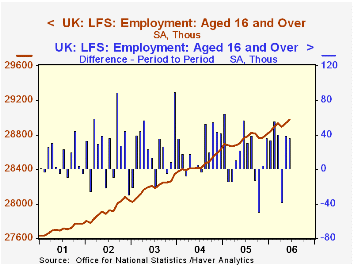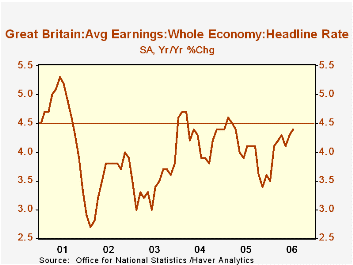 Global| Sep 13 2006
Global| Sep 13 2006UK Claimant Count Eases, Bringing Good News to Politicians, But Broader Unemployment and Employment Change Little
Summary
Prime Minister Blair gave away a key piece of UK labor market data Tuesday at a speech to the Trades Union Congress, letting people know that the so-called "claimant count" would see a "welcome" fall. Indeed, as the ONS reported [...]

Prime Minister Blair gave away a key piece of UK labor market data Tuesday at a speech to the Trades Union Congress, letting people know that the so-called "claimant count" would see a "welcome" fall. Indeed, as the ONS reported officially this morning, the number of people claiming the Jobseeker's Allowance eased to 950,100 in August from 954,000 in July and 955,000 in June. These compare to 869,300 in August 2005 and a monthly average of 861,000 for all of last year. While the monthly figure did decline then, the most that can really be said about the data is that it didn't worsen.
The UK's broader unemployment rate, following the widely used ILO definition, also indicated stabilization, but not improvement. It remained at 5.5% in the June reporting period, the three months centered on June, the same as in the May period. These compare with 4.7% a year ago. The number of people employed rose in the June period by 37,000 following a 39,000 gain in May. April's reading was down 38,000, so the three periods together leave employment in a very gentle uptrend, 0.8% higher than a year ago.
Markets focused on the lower claimant count, and they also noticed the rise in wages. The July reading on the average earnings index picked up to a 4.4% advance over a year ago, after June's 4.3% and May's 4.1%. Even so, the latest figure remains just below the Bank of England's threshold for inflation concern that sets in at 4.5%, suggesting that any monetary policy change won't come immediately, though some see a rate hike late this year. [The "AEI" is the index of average hourly earnings over the last three months relative to the same period a year ago. While the employment reading is generally taken on the middle month of a three-month moving average, the AEI highlights the ending month. So this is the "July" AEI, and the "June" employment and unemployment data, but they actually cover the same period: May, June and July.]
| UK Labor Force Survey & Related Labor Data | Aug 2006 | July 2006 | June 2006 | May 2006 | Year Ago | 2005 | 2004 | 2003 |
|---|---|---|---|---|---|---|---|---|
| Employment (3Mo Avg, SA, Thous) |
-- | -- | 28,975 | 28,938 | 28,755 | 28,743 | 28,465 | 28,183 |
| Chg from 1 & 3 Months Ago | -- | -- | 37/38 | 39/42 | +18 (MoAvg) | 1.0% | 1.0% | 1.0% |
| Unemployment Rate (3Mo Avg, SA, %) |
-- | -- | 5.5% | 5.5% | 4.7% | 4.8% | 4.8% | 5.0% |
| Claimant Count (Monthly, Thous) |
950.1 | 954.0 | 955.0 | 950.7 | 869.3 | 861.8 | 853.5 | 933.1 |
| Vacancies (Monthly, Thous) | 600.4 | 617.0 | 604.2 | 584.2 | 609.6 | 619.0 | 631.9 | 582.0 |
| Average Earnings Index inc Bonus (Headline Rate*) | -- | 4.4% | 4.3% | 4.1% | 4.3% | 4.1% | 4.3% | 3.4% |
Carol Stone, CBE
AuthorMore in Author Profile »Carol Stone, CBE came to Haver Analytics in 2003 following more than 35 years as a financial market economist at major Wall Street financial institutions, most especially Merrill Lynch and Nomura Securities. She had broad experience in analysis and forecasting of flow-of-funds accounts, the federal budget and Federal Reserve operations. At Nomura Securities, among other duties, she developed various indicator forecasting tools and edited a daily global publication produced in London and New York for readers in Tokyo. At Haver Analytics, Carol was a member of the Research Department, aiding database managers with research and documentation efforts, as well as posting commentary on select economic reports. In addition, she conducted Ways-of-the-World, a blog on economic issues for an Episcopal-Church-affiliated website, The Geranium Farm. During her career, Carol served as an officer of the Money Marketeers and the Downtown Economists Club. She had a PhD from NYU's Stern School of Business. She lived in Brooklyn, New York, and had a weekend home on Long Island.





